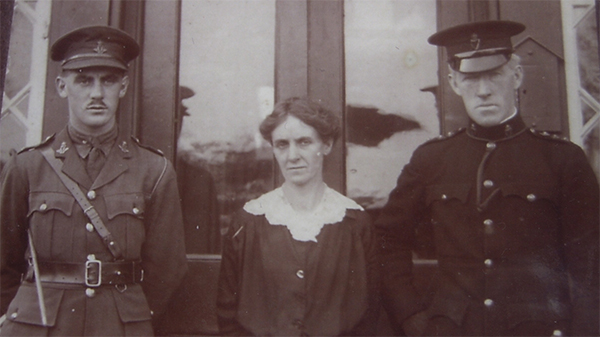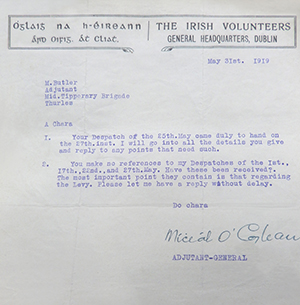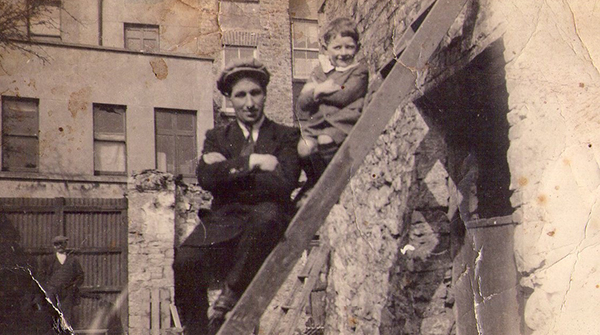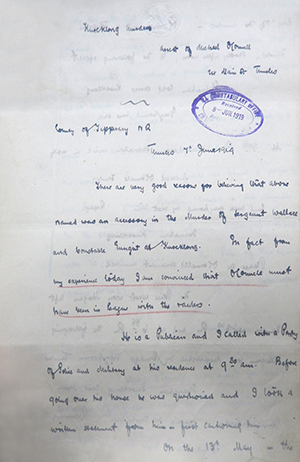The targeting of District Inspector Hunt—a template for the subsequent conflict?
Published in Features, Issue 2 (March/April 2020), Volume 28His assassination was ‘unmistakably the first blow in a methodical campaign of terrorism’.
By Neville O’Connell
On Monday 23 June 1919 the first horse-race meeting in three years took place on the outskirts of Thurles town. The organisers had advertised it throughout the country in an effort to make it an overwhelming success. Thousands were expected to be in attendance, and District Inspector (DI) Michael Hunt of the Royal Irish Constabulary (RIC) was to oversee policing of the event. After the final race at around 4.30pm, the good-natured crowds, as well as the district inspector, left the venue and made their way towards the town. Just as Hunt entered the town centre, three shots rang out. Wild panic ensued, as the crowds scattered in every direction away from the man who had just slumped to the ground. Within minutes DI Hunt was dead, the first RIC officer to be killed who had been specifically targeted by the Volunteers during the War of Independence.
Hunt’s background
Michael Hunt was born on 3 September 1873 in Killavil, Co. Sligo. He joined the RIC on 2 January 1893 and was married on 16 May 1900 to Kathleen Mary Bell, with whom he had six children. In his personal life Hunt was a very quiet, courteous and abstemious man who spent all of his earnings on his family. He showed himself to be a diligent and hard-working policeman and quickly rose through the ranks of the RIC. He was promoted to sergeant in 1901, head constable in 1907 and district inspector in 1911; his peers suggested that had he survived he would have been promoted to county inspector.

Above: RIC District Inspector Michael Hunt (right) with his wife Kathleen (née Bell) and son, Capt. Michael John Hunt, Royal Irish Regiment, outside their home at Railway House, Thurles, in 1918. (Jim Herlihy collection)
In 1915 Hunt took up the position of district inspector of Thurles. Following the death of his eldest daughter, Eva, at just fifteen years of age in December 1916, the once-prudent behaviour of the ‘level-headed’ policeman changed drastically. Hunt soon earned himself a notorious reputation among Republicans for doing his utmost to suppress the Sinn Féin cause. One month before his death, DI Hunt had been responsible for the arrest of the future minister for finance, Ernest Blythe, on the charge of possessing literature aimed at damaging the morale of the RIC. His pursuit of all those connected with the Volunteer movement in the years leading up to the War of Independence had won Hunt numerous recommendations for good police work, while his meticulous and aggressive tactics caused much consternation amongst the brigade and battalion officers of the Mid Tipperary Volunteers.
Motives for the assassination
On 13 May 1919, the daring rescue of Seán Hogan by members of the South Tipperary Volunteers at Knocklong railway station (see HI 27.3, May/June 2019, p. 70) led to the deaths of two RIC men, Sergeant Peter Wallace and Constable Michael Enright. Following the incident, an exhaustive search for the rescuers was undertaken by both the police and the military. In Thurles, the investigation into the Knocklong affair was led by DI Hunt. The deaths of the two RIC men appalled Hunt, who was their immediate superior. He said of the men:
‘The late Sergeant Wallace was a most honourable, upright and zealous officer and Constable Enright was a quiet, unassuming inoffensive man of whom there was no more honourable or respected man in the force. The death of Constable Enright is to be deplored.’

Above: The dispatch from Michael Collins found in Michael O’Connell’s possession, which led to the arrest of the quartermaster of the Mid Tipperary Brigade, Matthew Butler. This is the dispatch that was reported to Dublin Castle. (UK National Archives)
Over the next six weeks, DI Hunt focused his time and efforts on finding all those responsible for the deaths of his policemen. As his investigations progressed, he procured evidence that identified the acting brigade commandant of the Mid Tipperary Volunteers, Michael O’Connell, as having been directly involved in the rescue. O’Connell had monitored the movements of Seán Hogan while he was in custody and had communicated these by telegram to Hogan’s rescuers. Hunt had discovered these telegrams and was now closely observing O’Connell. The RIC county inspector, Ernest Mulliner, reported that
‘DI Hunt had but lately ascertained that telegrams were sent from Thurles to Knocklong giving details of the train by which [the] prisoner [Seán Hogan] was travelling. [There is] no doubt the Volunteers are aware of this and [are] determined to put a stop to his investigations.’
O’Connell knew that he was being investigated and was aware that his actions carried the death penalty. Around the beginning of June 1919, he decided that killing Hunt would be an effective way to disrupt investigations into the Knocklong rescue and approved plans to assassinate the district inspector.
On 7 June 1919, soldiers and police, led by DI Hunt, carried out an extensive and vigorous search of Michael O’Connell’s premises with revolvers drawn, while armed guards, with bayonets fixed, stood outside the house for hours. As he was considered ‘a dangerous fellow’, the police ‘rushed his room’ and subsequently questioned him about his involvement in the Knocklong rescue. Two guns and dispatches from Volunteer headquarters in Dublin were seized. O’Connell was arrested under the Defence of the Realm Act on a charge of having firearms in his possession. DI Hunt was happy to get this chance, as he strongly suspected O’Connell of involvement in the Knocklong rescue and wanted him in custody while investigations proceeded. A dispatch directly from Michael Collins found in O’Connell’s possession led Hunt to arrest the quartermaster of the Mid Tipperary Brigade, Matthew Butler, some hours later. In one day Hunt had arrested half of the brigade officers of the Mid Tipperary Volunteers. The county inspector again noted that ‘he [Hunt] has lately incurred bitter hostility over the arrest of Sinn Féiners O’Connell and Butler’.
The National Archives in London contain many of Hunt’s own letters regarding his investigations, and they show how determined he was in damaging the Sinn Féin cause. Examining the dispatches seized from Michael O’Connell, Hunt recognised the name of Michael Collins as ‘adjutant general of the Irish Volunteers’ and immediately wrote to Dublin Castle: ‘some of the documents I found are so important that I am sending them to headquarters by post tonight … This dispatch shows that there is more going on amongst Irish Volunteers in the country than is apparent on the surface.’
Hunt’s correspondence arrived the next day and it was immediately reported to the under-secretary that ‘the signature is that of Michael Collins, the adjutant general and chief of the Irish Volunteers. It is for consideration whether some immediate action should be taken against him [as Collins] will no doubt be soon warned about this seizure.’ The Volunteers did, in fact, already know about it. The feeling among them at the time can be summed up from a leaflet distributed widely by the Mid Tipperary Brigade: ‘Anyone who is against us merits no more consideration than a wild beast and should be killed without mercy or hesitation as opportunity offers’.

Above: Michael O’Connell, acting brigade commandant of the Mid Tipperary IRA in June 1919, with his son. (O’Connell family archives)
The succeeding brigade commandant of the Mid Tipperary Volunteers, James Leahy, wrote of the situation in his witness statement to the Bureau of Military History: ‘If this man [DI Hunt] continued to do this with impunity it could have disastrous results and that his shooting would have a salutary effect on other policemen who might be inclined to follow his example’. An opportunity to assassinate DI Hunt was expected to arise at Thurles races on 23 June 1919.

Above: Hunt’s letter to Dublin Castle headed ‘Knocklong murders’, concerning the arrest of Michael O’Connell, 7 June 1919—‘There are very good reasons for believing that the above named was an accessory in the murder of Sergeant Wallace and Constable Enright at Knocklong. In fact from my experience today I am convinced that O’Connell must have been in league with the raiders …’ (UK National Archives)
Death and inquest
Three Volunteers from the Mid Tipperary Brigade, armed with .45 Webley revolvers, attended Thurles races early on 23 June 1919—James and Tommy Stapleton (first cousins) and James Murphy. The trio trailed the district inspector for some time before they decided that their mission could not be completed inside the racing enclosure, owing to the strength of the armed soldiers present, who numbered about 60. At the conclusion of the final race, the military returned to their barracks while DI Hunt proceeded towards the thronged town centre, accompanied by a handful of RIC men. Using the crowd as cover, the gunmen closely followed DI Hunt, and as he entered the town centre they fired on him from close range in rapid succession. Two bullets entered Hunt’s body and the district inspector succumbed to internal injuries within minutes. The undisguised assailants took advantage of the wild panic, which scattered the crowd in all directions. They concealed their weapons and disappeared in the confusion. Shortly thereafter, the military and police took to the streets but there was little chance of identifying the attackers among the mass of fleeing crowds.
Some hours after he had died and the doctor had finished examining the remains, DI Hunt’s body was moved to his own residence. At the funeral two days later, the coffin was draped in the Union Jack and was followed by police and military. The cortège, however, included very few members of the public. Normal signs of sympathy, such as the closing of shutters and curtains along the route of the funeral, were not observed. The county inspector reported that not twenty members of the public attended the funeral. The police were appalled at the public’s reaction (or, more precisely, the lack of it) to the killing. Although the town centre had been packed, not one witness came forward and no information was provided to the police. At the inquest, which took place the following day, it was reported that DI Hunt was jeered at as he lay dying in the street. The jury was hesitant to bring in a verdict of ‘wilful murder’ against the killers and only did so after being cajoled by DI Wilson of Templemore, who represented the police (and who himself would be assassinated one year later by James Stapleton, the same man involved in the killing of DI Hunt). This boycott and lack of attendance at Hunt’s funeral was one of the first indications of a change in outlook by ordinary people regarding the Irish Volunteers. Many were now actively sympathetic to the Volunteers’ cause, while others were afraid of being labelled informants and the attendant consequences.
DI Hunt was buried with full military honours in Passlands Cemetery, Monasterevin, Co. Kildare, in the family burial plot of his wife on 26 June 1919. He was 45 years of age and left behind a wife and five children (Cecil, Kathleen, Vincent, Michael and Lilly) aged between eight and 21 years, the eldest of whom, Michael, served in the Royal Irish Regiment during the First World War and was a cadet in the RIC at the time of his father’s death. Following an award of £5,025 compensation to the family delivered at the Four Courts in March 1920, DI Hunt’s widow and five children emigrated to Adelaide, Australia, before returning to her home place in Monasterevin some time after the War of Independence had concluded.
Reaction
The events of 23 June 1919 received intense press publicity that revealed a rapidly deteriorating situation in Tipperary and brought the county to both governmental and international attention. Before the assassination there had been disagreement between the head of the Irish government, Viceroy Lord French, who wanted immediate aggressive action to be taken against the Volunteers, and the chief secretary, Ian Macpherson, who favoured a subtler approach. The events of 23 June tipped the scales in Lord French’s favour, and three days after the death of DI Hunt he telegraphed the following message to the UK cabinet in London:
‘The Irish Government are now forced to conclude that Sinn Féiners in this district [Thurles] are an organised club for the murder of police and that the time has come when Sinn Féin and its organisations in this district of Tipperary must be proclaimed an illegal organisation.’
Just over a week later, Sinn Féin, the Irish Volunteers, Cumann na mBan and the Gaelic League were banned in County Tipperary (a ban that would be extended to the whole of Ireland by September). The government declared Tipperary a special military area, with hundreds of extra police reinforcements being recruited throughout the region. This pushed the Tipperary Volunteers deeper underground in order to avoid conflict with the strengthened Crown forces. The county inspector of the RIC, Ernest Mulliner, was of the opinion that any ‘zealous and conscientious police officer … who brings one of its [Volunteer] members to justice is a marked man’ and tendered his resignation.
Conclusion
The shooting of DI Hunt was one of the most significant moments during the early stages of the War of Independence. Five police officers had already been killed as a result of ambushes and rescue attempts at Soloheadbeg, Knocklong and Limerick City (the Limerick workhouse rescue), but DI Hunt was the first RIC officer to be deliberately targeted in a planned execution by the Volunteers. The killing, and the subsequent reaction of the British government, established the pattern for many aspects of the War of Independence. The policy of killing policemen as an effective way of curtailing their investigations was adopted by Michael Collins some months later (see HI 27.4, July/August 2019, ‘Shooting “the Dog”: DMP Detective Sergeant Smyth—the first G Division casualty of the War of Independence’), while the ban on Sinn Féin and the Irish Volunteers in Tipperary was soon extended nationwide. The assassination of District Inspector Michael Hunt on 23 June 1919 was, as Charles Townsend put it, ‘unmistakably the first blow in a methodical campaign of terrorism’.
Neville O’Connell is a local historian from Tipperary, currently based in Vienna.
FURTHER READING
J. Connors, Seán Hogan: his life a troubled journey (Tipperary, 2019).
S. Hogan, The Black and Tans in north Tipperary: policing, revolution and war, 1913–1922 (Dublin, 2013).
















